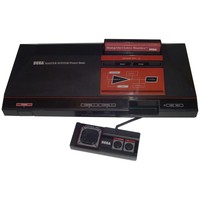Sega Master System
| Home > Browse Our Collection > Games Consoles > Sega > Sega Master System |
|
After the relative failures of the Sega SG-1000 and Mark II consoles against the might of the Nintendo Famicom, Sega launched their Mark III machine, which maintained backwards compatibility with the previous generations, while adding more technical capabilities to match the Nintendo console, this was further enhanced by an FM sound module add on. Sadly for Sega, this machine did not put a dent in Nintendo’s market share in Japan, largely due to third party games developers not being allowed to produce games for other companies if they had a license from Nintendo. In the US the Master System arrived well after the entrenched Nintendo NES, a lesson they would learn from when they launched their new machine the Mega Drive or Genesis as it was renamed over there, ahead of the new Nintendo machine. Sega looked to territories where there was little or no competition from its rival, it settled on Europe, partnering with Virgin Mastertronic to distribute the machine, and Tectoy for Brazil, both companies would do amazing jobs to get the machines onto their respective markets For Europe, the cartridge design was changed, so the machine's cartridge slot was wider than the Japanese model. It also did not have the FM module built into any overseas models.The Master System was also sold in packs, a basic one with just the machine, up to one that had 3D glasses and a lightgun. Having the console market largely to themselves, especially in the UK, Sega built up a strong following for the Master System, which laid the groundwork for the Mega Drive when it arrived in 1990. Sega had held the machine back in Europe for two years so not to impact the sales of the Master System. When it did arrive, the Master System was reduced in price, both in games and software as a machine for younger players. In 1992, the machine became the Master System II, a much cut down machine, removing the card slot and Composite scart socket, The machine was eventually discontinued in 1995. Looks wise the case is a striking black with red lettering, and gained interest for its sloping shapes and hard lines. On the top it has its main cartridge slot, a handy pause button, a card slot is on the front allowing the use of some pretty forward thinking peripherals such as the 3d glasses and a light phaser, it was also for playing small game cards which have their origin on the Sg-1000 Mark II redesign where the new boss of Sega Enterprises did not like the black cartridges of the original games, which he likened to tomb stones, thus creating the MyCard, a small credit card shape cart that on the Mark I and II needed an adaptor called the card catcher. * CPU: 8-bit Zilog Z80A Manufacturer: Sega Other Systems Related To Sega Master System:
This exhibit has a reference ID of CH4034. Please quote this reference ID in any communication with the Centre for Computing History. |
Click on the Image(s) For Detail
|














